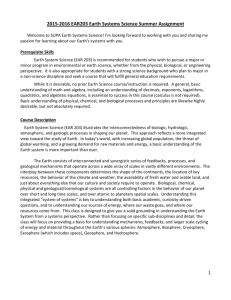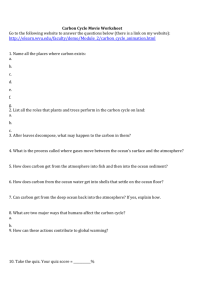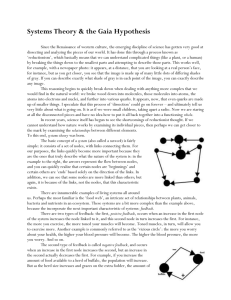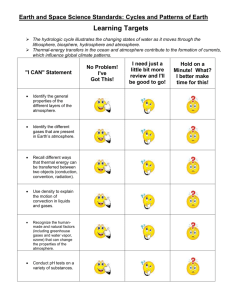Earth System Science and Gaia
advertisement
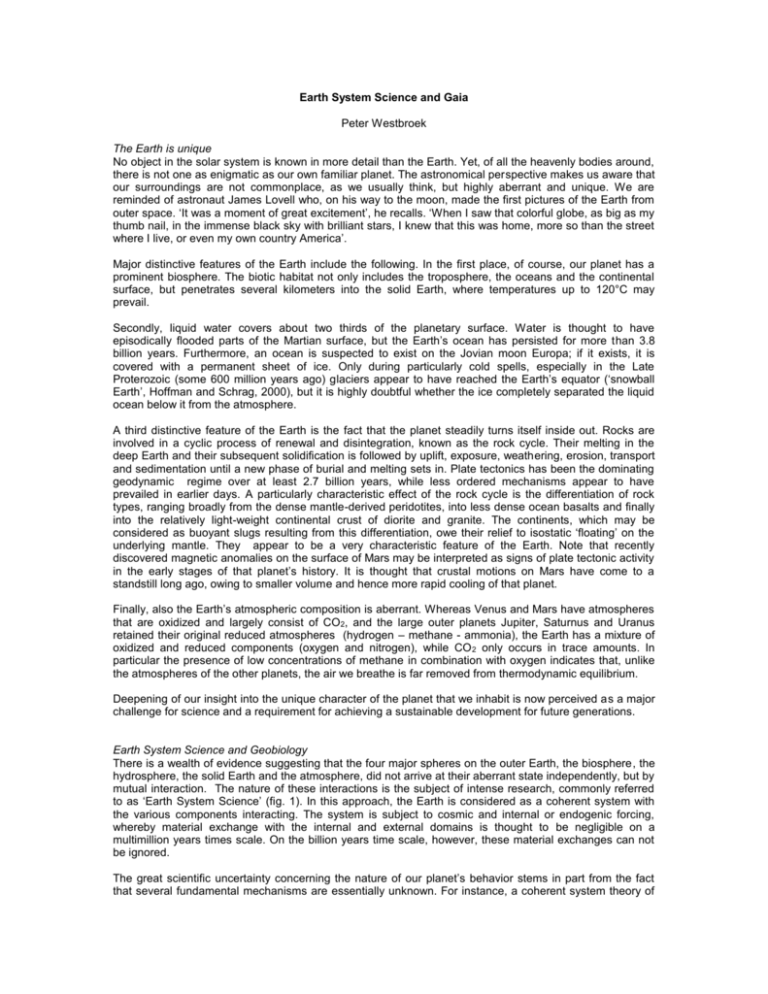
Earth System Science and Gaia Peter Westbroek The Earth is unique No object in the solar system is known in more detail than the Earth. Yet, of all the heavenly bodies around, there is not one as enigmatic as our own familiar planet. The astronomical perspective makes us aware that our surroundings are not commonplace, as we usually think, but highly aberrant and unique. We are reminded of astronaut James Lovell who, on his way to the moon, made the first pictures of the Earth from outer space. ‘It was a moment of great excitement’, he recalls. ‘When I saw that colorful globe, as big as my thumb nail, in the immense black sky with brilliant stars, I knew that this was home, more so than the street where I live, or even my own country America’. Major distinctive features of the Earth include the following. In the first place, of course, our planet has a prominent biosphere. The biotic habitat not only includes the troposphere, the oceans and the continental surface, but penetrates several kilometers into the solid Earth, where temperatures up to 120°C may prevail. Secondly, liquid water covers about two thirds of the planetary surface. Water is thought to have episodically flooded parts of the Martian surface, but the Earth’s ocean has persisted for more than 3.8 billion years. Furthermore, an ocean is suspected to exist on the Jovian moon Europa; if it exists, it is covered with a permanent sheet of ice. Only during particularly cold spells, especially in the Late Proterozoic (some 600 million years ago) glaciers appear to have reached the Earth’s equator (‘snowball Earth’, Hoffman and Schrag, 2000), but it is highly doubtful whether the ice completely separated the liquid ocean below it from the atmosphere. A third distinctive feature of the Earth is the fact that the planet steadily turns itself inside out. Rocks are involved in a cyclic process of renewal and disintegration, known as the rock cycle. Their melting in the deep Earth and their subsequent solidification is followed by uplift, exposure, weathering, erosion, transport and sedimentation until a new phase of burial and melting sets in. Plate tectonics has been the dominating geodynamic regime over at least 2.7 billion years, while less ordered mechanisms appear to have prevailed in earlier days. A particularly characteristic effect of the rock cycle is the differentiation of rock types, ranging broadly from the dense mantle-derived peridotites, into less dense ocean basalts and finally into the relatively light-weight continental crust of diorite and granite. The continents, which may be considered as buoyant slugs resulting from this differentiation, owe their relief to isostatic ‘floating’ on the underlying mantle. They appear to be a very characteristic feature of the Earth. Note that recently discovered magnetic anomalies on the surface of Mars may be interpreted as signs of plate tectonic activity in the early stages of that planet’s history. It is thought that crustal motions on Mars have come to a standstill long ago, owing to smaller volume and hence more rapid cooling of that planet. Finally, also the Earth’s atmospheric composition is aberrant. Whereas Venus and Mars have atmospheres that are oxidized and largely consist of CO2, and the large outer planets Jupiter, Saturnus and Uranus retained their original reduced atmospheres (hydrogen – methane - ammonia), the Earth has a mixture of oxidized and reduced components (oxygen and nitrogen), while CO 2 only occurs in trace amounts. In particular the presence of low concentrations of methane in combination with oxygen indicates that, unlike the atmospheres of the other planets, the air we breathe is far removed from thermodynamic equilibrium. Deepening of our insight into the unique character of the planet that we inhabit is now perceived as a major challenge for science and a requirement for achieving a sustainable development for future generations. Earth System Science and Geobiology There is a wealth of evidence suggesting that the four major spheres on the outer Earth, the biosphere, the hydrosphere, the solid Earth and the atmosphere, did not arrive at their aberrant state independently, but by mutual interaction. The nature of these interactions is the subject of intense research, commonly referred to as ‘Earth System Science’ (fig. 1). In this approach, the Earth is considered as a coherent system with the various components interacting. The system is subject to cosmic and internal or endogenic forcing, whereby material exchange with the internal and external domains is thought to be negligible on a multimillion years times scale. On the billion years time scale, however, these material exchanges can not be ignored. The great scientific uncertainty concerning the nature of our planet’s behavior stems in part from the fact that several fundamental mechanisms are essentially unknown. For instance, a coherent system theory of biological organization is missing (see however Kooijman 2000) and we are ignorant about the effects that the biota may have on endogenic activity (see however Anderson, 1984). Furthermore, a systems approach to the Earth requires that the multiple interactions be quantified as rigorously as possible, not only in the present situation, but also, by reconstruction from the geological record, in the geological past. The major stumbling block for progress in this field may be in the required transdisciplinary approach, as this asks for a profound cultural change in the practice of research. The impressive progress of science in the past 50 years caused a steady progression of specialization. Each discipline developed its own jargon, concepts and assumptions. As a result, a technical discussion between scientists from different fields became increasingly difficult. It is easily said that specialists in widely different disciplines must collaborate, but it turns out to be very hard to select transdisciplinary problems that can be adequately addressed. It is encouraging to see however that in scientific circles there is a growing enthusiasm for a new, integrated science of the Earth. Thousands of researchers make their specialized knowledge available in many transdisciplinary projects related to the System Earth. The understanding and quantification of the processes that link the biota with the rest of the world (fig. 1) remain the most elusive aspect of Earth System Science. Until a few decades ago, it was customary, in both geology and biology, to regard life as merely adapting to the interplay of non-biological forces. The reverse, i.e., the influence of life on the Earth’s dynamics was largely ignored. The main reason was that this influence is highly non-linear and therefore particularly difficult to quantify. As long as the science was concerned with reconstructing the broad outline of planetary history, geology and biology could better advance separately. However, with growing insights into the details, the study of life as a geological force became unavoidable. At present, the interactions between the living world and the non-living environment are perceived as a core subject in Earth System Science, known as Geobiology (fig. 1). In the following, I can merely illustrate a few of the geobiological interactions with some examples. Yet, I hope that this modest approach will help to communicate the flavor of this burgeoning field. By way of an introduction, it is useful to first epitomize some major features of the history of the Earth System. Earth System History in a day The Solar system (and thus also the Earth) is estimated to be 4.57 billion years old. In order to develop a first intimation with the time scale relationships of major geological events, it is useful to condense this long span of time into a single 24-hour day running from midnight to midnight. One hour in the Earth-day represents 190 Ma (million years), one minute 3 Ma and one second 50 thousand years. On this contracted time scale the origin of the Moon was at 20 minutes after midnight and the accretion of the Earth ended at 0 hr 30 minutes. By that time, the cooling of the planetary surface and the formation of the Earth’s core were completed and the original, dense atmosphere was lost. Until 3:55 AM an intense bombardment by meteorites destroyed most of the crust, and it is unlikely that life, if it was there, could have survived for extended periods of time. Despite this highly destructive regime, the oldest known remains of continental crust survived from 2:55 AM. Recently, minute crystals of the mineral zircon were discovered in a much younger parent rock, which was dated at 1 AM (Halliday, 2001). This is remarkable, as zircon is formed during granite formation, and in the presence of water. Thus, only half an hour after the end of accretion, continents, and probably even oceans, may have been present. The oldest indications of biological activity, carbon isotope signatures indicative of the biological fixation of carbon, date from 4 AM, only 5 minutes after the meteorite bombardment came to a halt, and the earliest fossils, of bacterial origin, were found in rocks as old as 4:45. The oldest recognizable remains of plate tectonic activity were formed at 10 AM. The Earth’s atmosphere remained reducing, with CO 2 and methane as major constituents) until about midday, when appreciable amounts of oxygen (to about 1% of present levels) began to accumulate. This event marks a major bottleneck for biological evolution, as, in principle, oxygen is a particularly aggressive poison. The hitherto prevalent anaerobic life forms were forced to retreat into anoxic refugia, such as the deep sea and the sediments, and only those with sufficiently effective detoxifying mechanisms were capable to survive in direct contact with the open air. Eukaryotic cells such as ours, with organelles and a nucleus, made their entry at about 5 PM. Thus, for 13 hours life has been exclusively bacterial. It should be stressed that the importance of bacteria has been much underrated in the past. We now know that virtually all metabolic pathways evolved early in Earth history within the bacterial world, and even today the biogeochemical cycles are predominantly catalyzed by bacteria. Eukaryotes, which themselves originated from bacterial by symbiosis, only occupy a limited niche of the vast repertoire of environments inhabited by the biota at large. Multicellular life arose around 8 PM, and the major body plans of the extant animals evolved within a surprisingly short period of 3 minutes around 9:10 PM, shortly after the severe ice age thought to have brought snowball-earth situations. Vascular plants colonized the continents at 9:50. At 2 minutes to midnight, humans arrived, and the industrial revolution took place at 3.7 milliseconds before midnight. On the Earth-day time scale, global cycling makes a memorable impression. At its present rate, the mean cycling time of the total sedimentary mass is 2 hours, and the ocean floor is renewed every half hour. The water in the oceans is being renewed every second and stirred at 200 revolutions per minute. In just 18 seconds, the rivers would deliver a mass of dissolved material equivalent to that already in solution in the oceans. It takes 0.2 and 140 milliseconds, respectively, to process all atmospheric CO 2 and O2 through the biosphere. Clearly, the uninterrupted presence of life from 4 AM to the present severely limits variations in the living environment, despite the frantic dynamics of the planetary system. For the continued reproduction of conditions under which life can survive, not only the lithosphere, but also the other components of the outer Earth system – hydrosphere, atmosphere, and biosphere – must have been in a recycling mode for a long time. Broadly speaking, the geological archive shows that the Earth system did not develop by gradual change, but was characterized by an alternation of long periods of stasis and sudden ‘events’, critical reorganizations that gave rise to new mechanisms and life forms. Some of these events are indicated above. In addition to oscillating regimes (e.g., between warm (‘green-house’) and cold (‘ice-house’) worlds), long-term trends are becoming apparent, not only in biological evolution, but also in the physics, chemistry and biology of global dynamics. Major examples of such trends are the conversion of a reduced to an oxidized atmosphere and the advent of plate tectonics. Life and the rock cycle The concept of the rock cycle was first formulated by James Hutton, by the end of the 18th century. In its present form it is connected with the theory of plate tectonics. The relief at the surface of the solid earth is generated by ’endogenic’ forces, such as mountain formation, volcanism, sea-floor spreading and subduction. The endogenic processes are driven by radioactive decay in the deeper Earth. On the other hand, ‘exogenic’ processes, which are powered by solar radiation, combine to equalize the relief. As soon as they appear at the Earth’s surface, the rocks are weathered. The resulting debris (pebbles, sand and clay) and dissolved materials (e.g., ions of calcium, bicarbonate and silica) are washed by rivers, glaciers and wind into the oceans (erosion and transport) and end up as sediments, ultimately those that cover the deep sea floor. From there the band wagon of sea-floor spreading transports the sedimentary mass via subduction zones into the deeper domains of the Earth. They are compressed and heated, and brought back up to the planetary surface in a subsequent cycle of mountain building and volcanism. Through their strategic position at the interface of rocks, water and air, and in the light of the Sun, living systems can play an active role in particular in those processes of the rock cycle taking place on the outside of the planet: weathering, erosion, transport and sedimentation. The nature of this biological intervention is best revealed by considering the contrast between the slow motion of plate tectonics and mountain formation in comparison with the frantic activity of life. Essential nutrients, such as phosphate, iron, copper or molybdenum are supplied in minute fluxes to the biota from the depths of the Earth. Hence, biological activity is maintained through the evolution of a huge variety of mechanisms whereby organisms can exploit to their own advantage the very limited nutrient supplies. Nutrient supplies are increased in the first place by dramatic speeding up of weathering by the activity of biological systems. Fungi, bacteria and plant roots penetrate into small cracks in the rocks and create microenvironments where the minerals can readily disintegrate. From a biological point of view, weathering may be compared with mining: raw materials are extracted from the rocks and supplied to living systems. The nutrients are then kept in circulation by extensive biological recycling. The weathered surface layers or soils play an important role in this repeated utilization. They form an indispensable substrate for vegetation: here, the debris of dead plants are broken down by organisms and the liberated nutrients are made available to the plants again. Excess nutrients are washed out or withdrawn from the biologically catalyzed circulation by storage in the tissues, by precipitation or evaporation, whereas limiting nutrients are usually recycled very efficiently. The nutrient fluxes tend to be diverted by the living communities in such a way that their concentration is adapted to local needs. Although living systems promote the breakdown of rocks in the weathering process, the resulting debris is kept in place as soils through multiple mechanisms. Overgrowth, roots and slime production are among the stabilizing factors. Nevertheless, the re-utilization of the nutrients is never exhaustive. The biologically catalyzed cycles are leaky and over the longer term the nutrients are diluted. Living communities are undermined and disappear; the soil cover is washed away and fresh rocks are brought to the surface. Now, the process can start all over. Meanwhile, the washed-out nutrients may stimulate biological activity downstream. In this way, life in the oceans is maintained by these nutrient fluxes. Ultimately, the used end-products of the biota are dumped on the deep-sea floor and enclosed in the slowly accumulating sediments. Sea-floor spreading will bring the refuse to a deep-sea trough where it is subducted. The sedimentary mass is subjected to high temperatures and pressures and pushed up during the formation of a mountain ridge. Thus, it is made available as raw material for a new cycle. Not only does plate tectonics serve as a sewage system for life, it also is responsible for the regeneration of fresh nutrients from the fluxes and refuse. It is doubtful whether life would persist for long in the absence of plate tectonics. While Figure 2a shows the classical, physical view of the rock cycle, Figure 2b shows the same process from a biological point of view. The behavior of living systems with respect to toxic materials is totally different. Like the nutrients, these substances may be liberated through the weathering of rocks. In addition, toxic compounds occur in air and in water, and they may even be generated as by-products of biologically catalyzed reactions. A huge variety of mechanisms has been described whereby poisonous materials are actively removed from biological systems. For instance, heavy metals may accumulate in the cell walls of many bacteria, to be kept away from cellular machinery. Dead or living organisms, loaded with heavy metals, are often taken up in sediments, so that the overlying waters are cleansed. In the ocean, poisonous materials are withdrawn from the upper water layers where planktonic organisms may bloom. Toxic nitrogen and sulfur compounds as well as, for instance, mercury, may be volatilized and released into the atmosphere. Thus, in contrast to the nutrients, toxic materials tend to be withdrawn from the biological circulation, or are even removed altogether from the biosphere. Some can be converted into useful or harmless materials and then be further channeled through the nutrient cycles. Ultimately, most toxic materials will end up in the deep-sea sediment, together with the final remains of the biota. After a very long time they may be brought back into circulation by the internal dynamics of the Earth. One aspect needs further clarification. The interaction of the biota with the rock cycle is an energy consuming process. Without solar radiation the process would soon come to an end. The light is captured by the biota and transformed into chemical energy. This energy is conducted through a fine network through the biosphere and sets the entire machinery in operation. Finally, it escapes in a low-grade form into space. The biosphere is a flimsy, but exceedingly complex and highly energized shell around the Earth. The geochemical fluxes wind together here into elaborate self-organizing and self-perpetuating networks. In the remote past they have emerged from non-biological geochemical fluxes. This is life: a very special geochemical process. Biochemistry is a constituent part of geochemistry. Emiliania – amplification in biological forcing The example of the marine unicellular alga Emiliania may serve to demonstrate the highly non-linear character of the biological involvement in Earth dynamics. The cell (fig. 3a), about a hundredth of a millimeter in diameter, is surrounded with elegant scales of calcium carbonate, or chalk. These scales, or coccoliths, are produced in a special vesicle inside the cell and when their formation is completed they are transported to the cell surface. Emiliania occurs in astronomical numbers in the oceans. The cells tend to divide each night and periodically, in particular during the late spring in the North Atlantic at mid-latitudes, there seems to be nothing to stop their proliferation. Huge blooms are the result, which may be viewed from space (fig. 3b). These blooms may last for several weeks, until they are terminated by grazing crustaceans or viral infection. The cells and the coccoliths sink to the ocean floor. Emiliania is one of the most numerous organisms on Earth. Emiliana in one out of several hundred species of planktonic organisms that produce calcium carbonate and live in the upper, illuminated, layer of the ocean water column. Together, they influence the rock cycle as well as the world’s climate. The export of calcium carbonate and organic material from the blooms to the deep ocean removes carbon from the atmosphere. This process effects the concentration of carbon dioxide, the greenhouse gas. In addition, the blooms emit a sulfur-containing gas to the atmosphere, DMS. Higher up in the atmosphere, this gas is oxidized to sulfuric acid droplets which facilitate the formation of white clouds. Because these clouds reflect the solar radiation, they have a cooling effect. In addition, they cause the precipitation of natural acid rain. The chalk and organic carbon that sink to the ocean floor form thick layers which accumulated during millions of years. Such layers are locally exposed in the chalk cliffs of Dover, Cap Blank Nez (Boulonnais) and Etretat. These sediments form a geological archive, used to reconstruct the long history of this system. The origin by evolution of coccolith formation occurred some 200 million years ago. It depended on the ‘invention’ of a minute vacuole in the cell, and extended the area of calcium carbonate sedimentation from the periphery of the oceans (coral reefs) to the main ocean floor. Model studies suggest that this geological event had major climatic consequences. As the huge masses of calcium carbonate on the ocean floor entered into the deeper Earth at subduction zones, they gave rise to a substantial increase of CO 2 emissions into the atmosphere through volcanism. Without the tiny vacuoles we might now be locked up in a very severe ice age. The Emiliania phenomenon provides a good example of transdisciplinary science. More than a hundred scientists participate in this research. Among them are geneticists, physiologists, ecologists, oceanographers, climatologists, geologists and modelers. The underlying idea is that the understanding and quantification of this phenomenon may serve as a model for the study of geobiological interactions in general. Oxygen A telling example of the interaction between biological and geological processes is the problem of how the original, reducing atmosphere could change into the present oxidized atmosphere some 2.2 billion years ago. Figure 4 represents the underlying mechanism. Free oxygen is a by-product of photosynthesis, the process whereby certain microorganisms, algae and plants convert solar radiation into the chemical energy on which virtually all further life depends. The relatively inert carbon dioxide and water are converted into a reactive mixture – organic matter (CH2O) and oxygen. Respiratory processes reverse the reaction, so that carbon dioxide and water are regenerated. It must have had its beginnings shortly after the origin of life. The cycle is leaky, however: a small portion (about one thousandth) of the organic carbon which is produced in the biological cycle is enclosed in the accumulating sediments. It remains there for a very long time (the mean residence time is in the order of 300 million years), until it is exposed by tectonic forces at the continental surface. It then reacts with oxygen and is re-converted into CO2 and water by weathering. Thus, a gigantic reservoir of organic matter could be formed in the Earth’s crust, about 15,000 times the total living biomass of today. For each molecule of organic carbon withdrawn in this way from the biological circulation, one molecule of oxygen was liberated. Originally, however, the gas could not accumulate in the atmosphere. It reacted immediately with reduced iron and sulfur brought up by the rock cycle, and as a result huge reservoirs of oxidized iron and sulfate (rust and gypsum) were stored in the crust together with the organic carbon. Thus, a steady geochemical trend, whereby iron and sulfur were transferred from the reduced to the oxidized state, was characteristic for the early development of the Earth. Finally, a steady state situation emerged where the oxidation and reduction rates of iron and sulfur equaled out. It was at this point that oxygen could freely accumulate in the atmosphere. Thus, in Figure 4, the biological cycle acts as the producer and the geological cycle as the accumulator of atmospheric oxygen. As a result of these interactions, the Earth has stored a huge amount of fossil energy over geological time; this planet is a chemical battery with the oxidized pole at the outer and the reduced pole at the interior of the planet. The fact that the atmospheric composition is far removed from thermodynamic equilibrium is a corollary of this energized state of the planetary system. It is also clear that biology or geology alone cannot explain the evolution of the oxygen atmosphere. Present research, focusing on the finer details of this crucial trend in Earth history, requires an ever closes collaboration between specialists in these two fields. This research now relates to the origin and evolution of photosynthesis and respiration, and to the efficiency of these processes, as they depend on nutrient availability in the oceans. At least as significant are secular changes, both in the accommodation space for sediment accumulation and in weathering rates. It now appears that the present level of oxygen at 21% of the total atmosphere was only reached in the Late Paleozoic, less than 400 million years ago. The colonization of the continents by vascular plants is likely to have played a crucial role in this event. It should be noted that the scenario of fig. 4 may not fully explain the original oxygenation of the atmosphere. The figure accounts for recycling of the organic reservoir in the geological cycle, but does not provide a mechanism by which the size this reservoir could sufficiently increase for free oxygen to accumulate. Catling et al. 2001, and Kasting 2001 introduce a new hypothesis which they believe to operate over and above the recycling of organic matter. They provide evidence suggesting that abundant methane, released by biological systems under the original anoxic atmosphere, would disintegrate in the high atmosphere upon exposure to solar radiation. Molecular hydrogen released in this process would have escaped on a massive scale into space, leaving the outer earth in an increasingly oxygenated state. Once oxygen could accumulate in the atmosphere, the methane was oxidized in the lower atmosphere, so that the flux of hydrogen into space was quenched. It should be emphasized that this proposal can only strengthen the argument that the evolution of atmospheric oxygen can only be understood by transdisciplinary research involving both biology (the production of methane) and the physical Earth sciences (disintegration of the methane and hydrogen release). Global regulation and Gaia The preceding examples may sufficiently illustrate the importance of life as a forcing factor in Earth dynamics. It should be kept in mind that this influence is rarely if ever exerted by biological activity alone. The majority of the geological processes affected by biological systems would also proceed in the absence of life. Only in combination with physical and chemical processes could the immense impact of life accumulate over geological time. The idea of global regulation brings the argument one step further. Lovelock (1979, 1988. 2000) drew attention to the fact that life continued without interruption from 3.8 billion years to the present day, despite a 25% increase in solar radiation and major catastrophic events, such as meteorite impacts that periodically devastated the external planetary domain in this long period of time. Lovelock explained this observation by proposing that the Earth is an organized entity. Global regulatory mechanisms, emerging from the multiple interactions between life and its environment, automatically maintain favorable conditions for the long-term survival of the biota. There is no need to invoke forethought or planning. No deus ex machina is required. The system, which he termed ‘Gaia,’ maintains itself like the flame of a candle. Lovelock compared the Earth with a superorganism, which maintains internal homeostasis, just as we maintain the blood pressure or temperature in our bodies. The ‘Gaia hypothesis’ has been refuted on the ground that it cannot be falsified (Kirschner, 1991). Gaia would be true no matter what the facts are. Furthermore, the analogy with a superorganism is flawed because the Earth does not reproduce, and cannot evolve through natural selection in the absence of competitors. In addition, geological history shows that the Earth is not truly homeostatic, as the system has undergone major changes during its existence. Despite these criticisms, an impressive influence of the Gaia hypothesis on Earth System Science cannot be denied. Firstly, the Gaia idea gave a new fuel to the systems approach, which had already been explored by Vernadsky, and in more recent years by the schools of Robert Garrels, Heinrich Holland and many others. Secondly it brought to the fore the idea of global regulation. Since the Gaia idea has been put forward, several globally operating feedback mechanisms, both negative and positive, have been proposed. Examples are the calcium silicate carbonate cycle, shown in Figure 5, and modeled by Berner (1994) (see also Lovelock and Kump, 1994, and Westbroek, 2000), and a proposed mechanism for the regulation of atmospheric oxygen (Watson and Lenton). Despite these early advances, our understanding of global regulation is very incomplete. Few feedbacks have been studied in any detail and many are likely to be discovered in the future. It should be borne in mind that Gaia is about the behavior of the entire earth system as it emerges from all co-evolutionary interactions and feedbacks together. Clearly, a deep understanding Gaia is still out of reach. Nevertheless, I personally feel that the term Gaia is to be preferred over the more commonly used ‘Earth System Science’. The latter term gives little incentive to biologists to collaborate with geologists. Furthermore, ‘Gaia’ reminds us of our profound ignorance of the Earth’s dynamics and history. And finally, the name of the ancient Greek goddess attracts the attention of the public at large and helps to bring world-wide respect for the planet that we inhabit. References Anderson, D.L., 1984. The Earth as a planet: paradigms and paradoxes. Science 223: 347-354. Berner, R.A., 1994. Geocarb-II – A revised model of atmospheric CO2 over Phanerozoic time. Amer. J. Sci. 294: (1) 56-91 Catling, D.C., Zahnle, K.J., McKay, P., 2001. Biogenic methane, hydrogen escape, and the irreversible oxidation of early earth. Science 293, 839-843 Halliday, A.N. 2001. In the beginning… Nature 409: 144-145. Hoffman, P.F. and Schrag, D.P., 2000. Snowball Earth. Scient. Amer. 282, 68-75. Kasting, J.F., 2001. The rise of atmospheric oxygen. Science 293: 819-820 Kirchner, J.W., 1991. The Gaia hypotheses: are they testable? Are they useful? In: Scientists on Gaia, S.H. Schneider and P.J. Boston, eds. MIT Press, 38-46. Kooijman, S.A.L.M. 2000. Dynamic energy and mass budgets in biological systems. Cambridge Univ. Pr, Cambridge. Lovelock, J.E., 1979, Gaia: a new look at life on Earth. Oxford Univ. Press. Lovelock, J.E., 1988. The ages of Gaia. A biography of our living Earth. Norton, New York, London. xx + 252 pp. Lovelock, J.E. and Kump, L.R., 1994. Failure of climate regulation in a geophysiological model. Nature 369: 732-734. Lovelock, J.E., 2000, Homage to Gaia. Oxford Univ. Press Watson, A, and T. Lenton, 2000. Global Biogeochemical Cycles. Westbroek, P. 2000. Let’s reclaim Gaia for science. Palaeontologia electr. 3(1). ISSN 1094-8074. Figure 1. The subject of Earth System Science Figure 2. The rock cycle. A. From a geophysical, and B. from a geobiological point of view. Fig. 3. Emiliania. Left: a single cell (diameter one hundredth of a millimeter) with coccoliths of chalk. Right: a bloom South of Iceland, as seen from space. Figure 4. Production and accumulation of atmospheric oxygen through the coupling of the biological and geological cycles of organic carbon. Note rapid recycling and small global reservoirs in the biological cycle, and slow recycling and huge reservoirs in the geological cycle. Fig. 5. The calcium silicate-carbonate cycle as a global thermostat. Weathering of one mole of calcium silicate (CaSiO3) the continents requires 2 moles of atmospheric CO2 (and water – not shown). Rivers transport the dissolved weathering products (ions of silicic acid (H 4SiO4), calcium (Ca++) and bicarbonate (HCO3-)) into the ocean. These substances are removed from the ocean water by precipitation of silica (SiO2) and limestone or chalk (CaCO3). Upon the precipitation of limestone, one mole of CO 2 is returned to the atmosphere. Subduction of the deep-sea sediments at deep-sea trenches is followed by re-generation of calcium silicate and the volcanic release of one mole of CO 2. An increase in subduction rate leads to an increased atmospheric concentration of CO2 and to climatic warming. At higher temperatures, the weathering rate increases and CO2 is pumped away from the atmosphere more rapidly, leading to a lowering of the temperature. This system acts as a global thermostat over times scales larger than 1000 years. Asterisks indicate biologically enhanced processes.
